Be honest! Have you ever thought that the pricing models for B2C customers would be suitable for B2B (wholesale) customers? Are B2B pricing strategies justified for the average consumer?
Building price strategy has always been one of the most critical jobs that store owners care about while running an eCommerce business. The product’s price directly affects how much sellers earn per purchased item and how competitive that product is. For that reason, smart pricing is the key to profits in the intense competition.
If you are doing both B2C and B2B, you should know that each business model requires a different pricing strategy.
As you know, the natural purpose of making purchases already differs from B2C to B2B customers. B2C customers buy a solution to solve their problem while B2B customers resell those solutions to thousands of others who require solving problems. That’s why you should treat them differently.
In this article, we will reveal all the secrets of Magento’s wholesale pricing strategy to price smartly.
Let’s get on a ride to understand which pricing strategies will work for B2B customers and which will not!
TRY Magento 2 B2B Extension – The all-in-one package of solutions diversifies B2B pricing for your business!
Key Benefits Of B2B Pricing
Table of Contents
Pricing plays a strategic role in B2B. Not only does pricing affect store owners’ profit, but it also helps them target profitable customers and maximize sales.
Increase profit
Obviously, prices affect your profit. The higher the price, the higher profit you get.
Usually, for wholesale customers, you have to offer great deals to attract them. Because of it, you will likely get low margins if you do not have a wise pricing strategy.
Target profitable customers
Pricing should be consistent with the customer base that you target. Proper pricing allows your store to target your profitable customers more easily.
On the other hand, you also can use pricing strategies to create barriers for unprofitable or unwanted customers.
Maximize Sales
A typical feature of wholesale pricing is quantity discounts. If customers want to receive a wholesale price for their orders, they have to buy as many as a required threshold of the products.
You can specify different discounts for each threshold of order quantity. This is a common and effective way to boost sales.
Because of those reasons, every Magento wholesale website needs a smart pricing strategy to make not only profits but also maximize profits.
The Complete B2B Pricing Process
What surprised me the most is that there is a large number of entrepreneurs who rely on emotions to offer a reasonable price for their products.
They use that emotional price to sell their products/services to B2B customers without foreseeing the harms of such irrational action on their businesses.

A product price is always associated with a balance of loss and profit. Reasonable pricing is essential, requiring a scientific and controlled B2B pricing process.
The pricing process for B2B customers includes the following steps:
Product Understanding -> Price Model -> Price Research -> Price Strategy -> Index Price
Regardless of product understanding, this article will go straight into three recommended price research methods for wholesale, three popular pricing strategies for B2B customers, and finally, four typical pricing models.
The 4 Typical B2B Pricing Models
When picking a pricing model for your business, you need to consider two questions:
One: Are you going to offer one or multiple price points?
Two: Which value metric are you going to use?
After they have the answer to those questions, it will be easy to pick one of these four common pricing models.
B2B flat-rate pricing model
The flat-rate pricing model means charging a fixed price for a product.
Using this model, it will be easy to sell and communicate. All the sales and marketing strategies can focus on a single offer.
But, the flat-rate pricing model prevents you from maximizing revenue.
The price might be too high for price-sensitive customers or might be too low for some who are willing to pay more.
Typically, flat-rate pricing is only suited to businesses that have one product and limited revenue.
B2B tiered pricing model
The tiered pricing model is a pricing method based on different segments in the same price range to attract a wider audience of B2B customers.

In wholesale, since the buying/selling product quantity will often be large, setting different tiers for price and discounts will help stimulate B2B customers to buy more, which often results in higher sales for your business.
This pricing model is best suited for the case of excess stock and category control, especially when you already have an edge of pricing advantage compared to competitors.
B2B dynamic pricing model
Dynamic pricing is a model that does not follow a fixed price but dynamically changes the price to suit the actual situation and the factors affecting it.
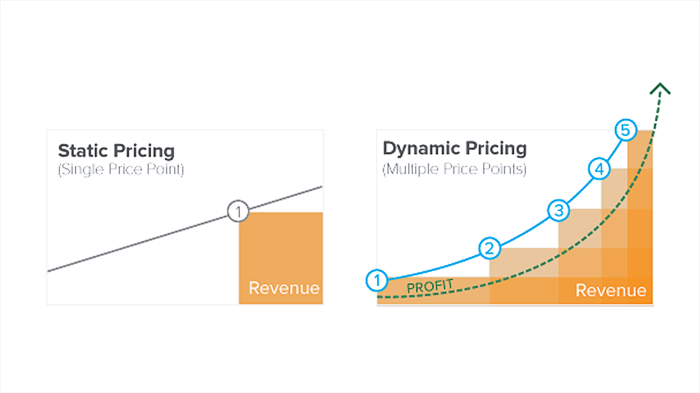
To name a few, inconsistent cost, different timing, or multiple customer segments could be the standard for the change of dynamic pricing.
Dynamic pricing also isn’t a new pricing model but has been applied a lot in areas such as aviation, transportation, tourism, or even chemicals. These are all areas that require price flexibility to minimize costs/increase profits for each service execution.
Applying dynamic pricing for B2B, prices will need to change flexibly based on your subjective and objective assessment of a different B2B audience or group of customers.
You will undoubtedly need data and temporary insights to be able to divide them into groups of customers with certain similarities and consistency.
B2B lead generation pricing model
Typically, only service-related businesses use lead generation pricing models for B2B customers since it depends on the marketing costs for the service.
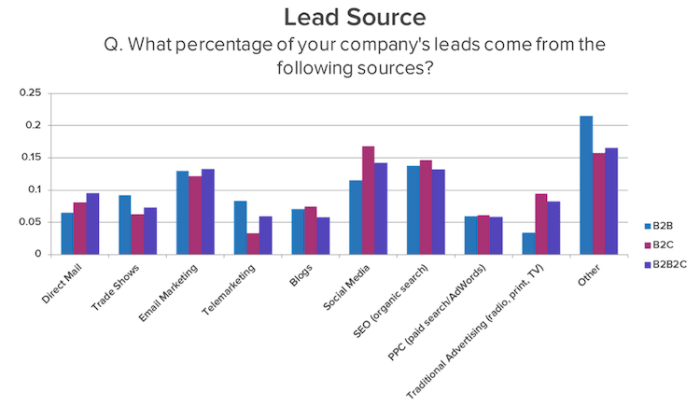
To put on a suitable price, you would use marketing parameters:
- PPL (pay-per-lead).
- PPC (pay-per-click).
- PPCALL (pay-per-call).
Combining them all with other production costs, you should determine the correct price to satisfy the upcoming demand.
The 3 Suggested B2B Pricing Research Approaches
Before choosing B2B pricing strategies, you must conduct pricing research to learn more about your product/service. And there are many ways to learn and determine how to price a product, which is divided into:
- Direct research technique: evaluate and determine the price through knowledge and understanding of the value of the product/service.
- Indirect research technique: review and compare prices with other attributes of the product/service as well as the whole package.
In this section, I will introduce to you the top 3 approaches to study your product price for suitable B2B pricing strategies.
The academic approach
A pleasing way to consider and choose the right price strategy is to answer Van Westendorp’s set of four price questions (also known as Van Westendorp’s price sensitivity meter).
- At what price would your customers think of your product as a bargain – a great buy?
- At what price would your customers think your product is getting expensive yet still consider buying it?
- At what price would you begin to think your product is too expensive for a buying decision?
- At what price would you begin to think your product is so inexpensive to question its quality?
Answering all the questions and putting them on the chart would give you an idea of what your acceptable range for the product is.

As direct as it is, unlike B2C, Van Westendorp’s price sensitivity meter isn’t entirely practical for B2B pricing since it’s hard to get your hand on the appropriate wholesale data to answer these questions correctly.
Most marketers and consultants find this method unappealing, so it’s best for you to only look at it as a reference.
The pragmatic approach
To make pricing research more accessible and more relevant for B2B customers, you can use other practical, pragmatic approaches.
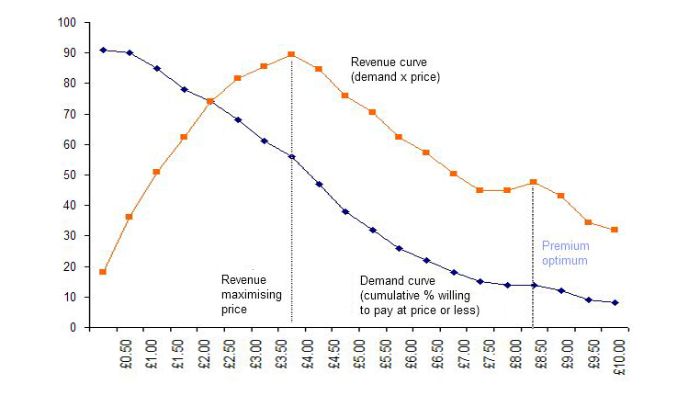
Use these set of questions below as a reference for planning the acceptable pricing range of your product/service:
- At what price range is your product/service worth to your customers?
- What problem does your product/service solve?
- How costly is that problem? (with or without your product/service)
- At what price range can your customer afford to pay for your product/service?
- How much does it cost to produce/deliver your product/service?
- What do your customers perceive as the value you’re offering?
If your #5 answer is higher than your #1 and #3 answer, then your cost is certainly higher than your profit, which means big trouble.
These six questions would be a good starting point for you to choose an appropriate pricing strategy from the three that I have listed above.
The conjoint analysis
Conjoint analysis, also known as discrete choice analysis, is a form of determining the best pricing strategy for B2B customers.

This approach allows you to test different prices under different circumstances to figure out what is the most profitable and most profitable range of prices.
Participants are shown 3 to 4 matching products/services at the same time. Each product/service will list different attributes, such as size, color, features, durability, etc.
The participant must choose only 1 product/service in it, and they mustn’t give you the reason for their choice. They would have to repeat this test multiple times, and each time the product attributes would be scrambled, and they had to reselect the product.
The result will give enough data to analyze which properties are preferred and what their essential values are.
From this information, you can quickly determine which price range is preferred and what pricing strategy is most fitted to your business.
The 3 Popular B2B Pricing Strategies
In totals, there are ten strategies, yet only these three pricing strategies are the most popular for B2B. Let’s discover why they’re used that much!
Cost-plus-pricing strategy
The Cost-plus-pricing strategy is the simplest and easiest to implement of the three pricing in B2B marketing strategies introduced in the article.
Instead of having to analyze and conduct hours of surveys about the market or competitor, as a business owner, you can quickly come up with a price without wasting time or effort!
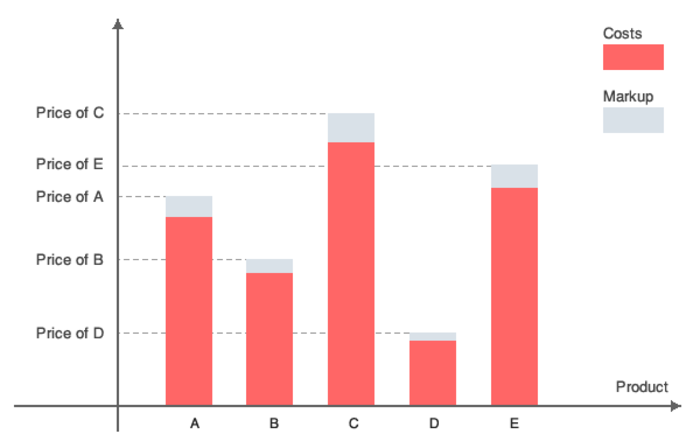
The way to do it is straightforward. You just need to set the price based on the following formula:
Cost + Markup Percentage x Cost = Target selling price.
The markup percentage is calculated based on available market knowledge as well as the competitive ability of your business/product.
The target selling price at this time will ensure coverage of the general cost (development, production, shipping, marketing, etc.) and bring about an appropriate percentage of profit.
However, I strongly discourage you from using the cost-plus-pricing strategy for B2B clients because of its lack of initiative, isolation, and lack of customer engagement.
You should only choose this pricing strategy when:
- You don’t have enough time to do market, customer, or competitor research.
- You need to focus more on other aspects of your business, like shipping, marketing.
- Your product line does not have too much variation in price competition.
Besides, this B2B pricing strategy isn’t suitable for SaaS businesses due to the nature of the benefits of the product/service, which already outstrips the cost of creating the product.
Competitive pricing strategy
The competitive pricing strategy is a strategy frequently used in the market due to its convenience.
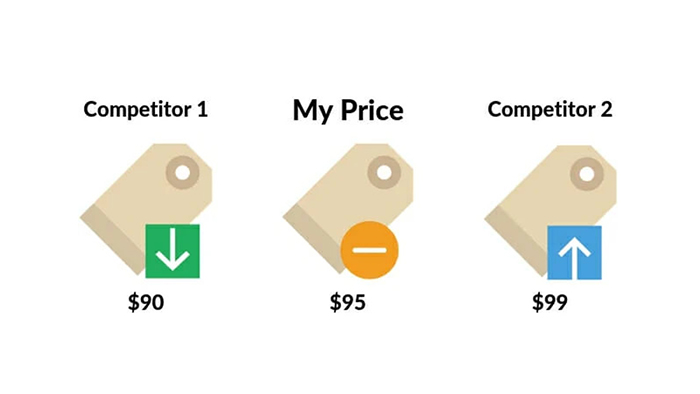
It’s straightforward. You simply need to take into account the average price of other B2B competitors in the industry for the same product.
If you don’t know how-to, try using this formula:

Last but not least, don’t forget to compare the price you just got to other competitors’ prices.
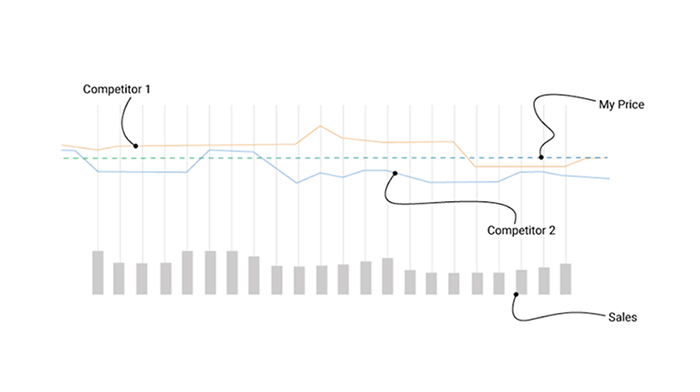
Either by wanting to gain an edge of advantage in price or merely raising it for a better profit, you can subtract or add a few percent to get the final price of your product.
This Business to Business pricing strategy is commonly used to gauge the price competitiveness of products relative to competitors, and in most cases, they are pretty accurate.
However, their disadvantages stem from their very nature.
The final price offered by this pricing strategy often lacks the accuracy in evaluating your service/product value nature.
If you are not careful, you may miss the opportunity to make more profits or simply get caught up in the price race of B2B, especially in the eCommerce market.
Value-based pricing strategy
Instead of ignoring the customer factor and using pricing parameters to compete and determine the right price, a value-based pricing strategy uses survey sources and B2B customer data as the core of product pricing.
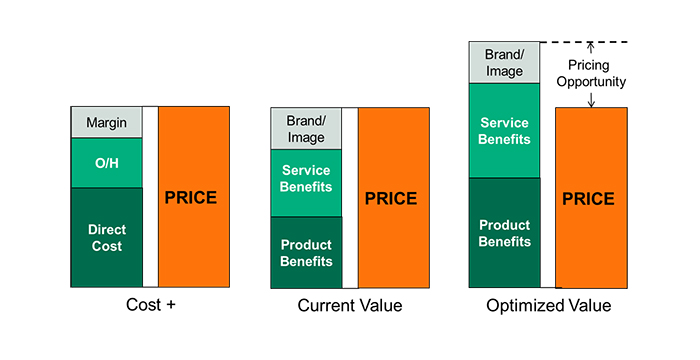
Price would be decided accurately based on the value of the product and the price that the customer is willing to pay for them.
Of course, this price policy has its drawbacks. The biggest downside of this Business to Business pricing strategy is the preparation time as well as the problem of data collection.
You must ensure three factors: data quality, preparation time, and monitoring process.
- Data quality requires you to take a survey to get the most accurate B2B customer insights.
- Time is needed as the crawl will take long before finished.
- The monitoring process must be rigorous to secure the research information to perform continually.
To get the right price, you need to build a personal profile of each customer and determine what the fair price for them is.
Extra: B2B Pricing Personalization Display in Magento 2
What if you apply a competitive strategy or dynamic pricing model to your product but fear that your competitor will follow and imitate the adjusted price for the sake of gaining an edge on the market?
Default Magento 2 has no such hidden pricing function. The other useful functions, such as requesting a quote or setting custom prices, only appeared in Magento 2 B2B Commerce version, which costs a fortune to set up.
To understand your needs, BSSCommerce has developed a solution for a more proactive display of prices on product pages: Magento 2 Hide Price extension.
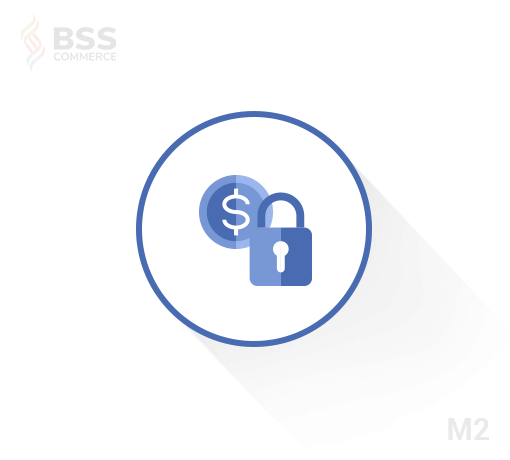
Magento 2 Hide Price extension allows you to hide product prices/catalog prices as desired. You can also set to show retail prices to B2C customers while hiding wholesale prices and showing contact invitations for approved B2B customer accounts.
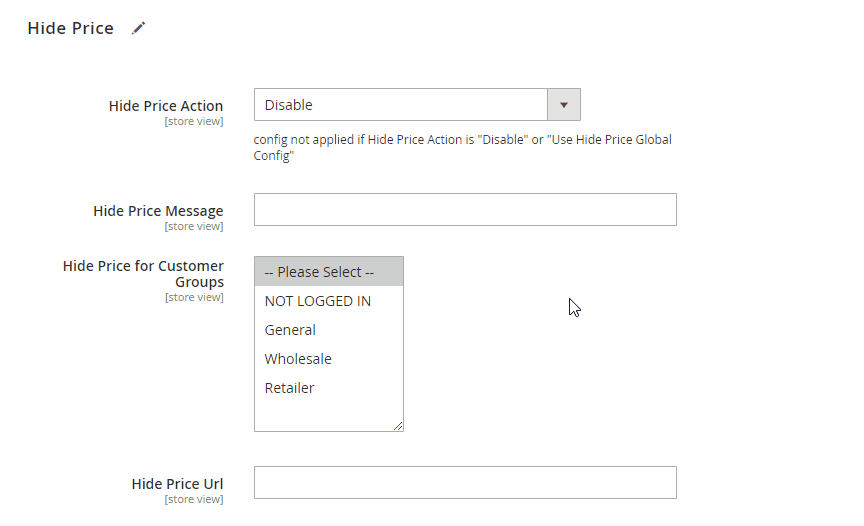
You should use the Hide Price extension together with Magento 2 Request for Quote extension.

B2B customers are hardly satisfied with only the displayed price on the product page. Therefore a quote could help buyers and store owners negotiate about product prices and then go to the end agreement.
Customers add products to quotes and submit them to store owners. In case store owners approve the requests, customers can convert quotes to orders and checkout.
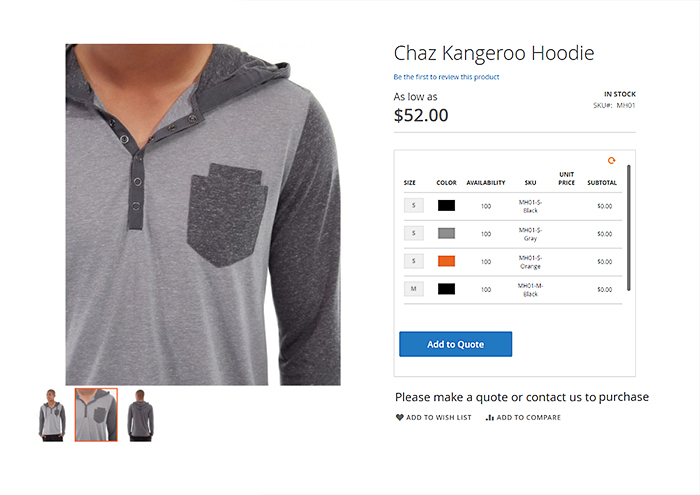
For even better pricing management, you can also choose to approve, reject or customize the quote as desired.
To let B2B customers browse the same category and product pages as B2C customers while seeing a different adjusted price, try using Magento 2 Custom Pricing extension. You can also set up specific price rules if needed for the suitable application of the B2B tier pricing model.
Conclusion
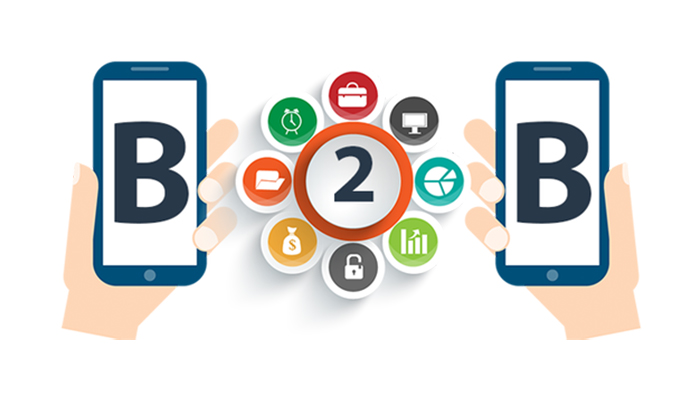
Scrolling to this part means that you have finished reading our article. We hope that our mentioned B2B pricing strategies would be an excellent suggestion for you to complete your product price.
If you’re already using Magento 2, I sincerely hope that you find our solutions for displaying price as an excellent addition to your website.
In case you have any issues with B2B eCommerce pricing, let’s share with us!
SCOUR NOW >> Master 4 Magento Wholesale Pricing Strategies To Maximize Profit for more details information.
BSS Commerce is one of the leading Magento extension providers and web development services in the world. With experienced and certified Magento developers, we commit to bringing high-quality products and services to optimize your business effectively. Furthermore, we offer FREE Installation – FREE 1-year Support and FREE Lifetime Update for every Magento extension.
CONTACT NOW to let us know your problems. We are willing to support you every time.

